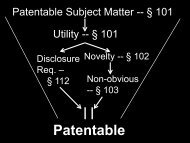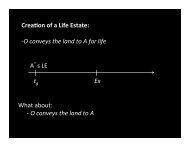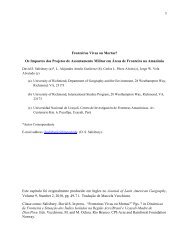Making the case for Cauchy transforms
Making the case for Cauchy transforms
Making the case for Cauchy transforms
Create successful ePaper yourself
Turn your PDF publications into a flip-book with our unique Google optimized e-Paper software.
<strong>Making</strong> <strong>the</strong> <strong>case</strong> <strong>for</strong> <strong>Cauchy</strong> trans<strong>for</strong>ms<br />
William T. Ross<br />
University of Richmond<br />
William T. Ross (University of Richmond) <strong>Making</strong> <strong>the</strong> <strong>case</strong> <strong>for</strong> <strong>Cauchy</strong> trans<strong>for</strong>ms 1 / 42
Prolog<br />
William T. Ross (University of Richmond) <strong>Making</strong> <strong>the</strong> <strong>case</strong> <strong>for</strong> <strong>Cauchy</strong> trans<strong>for</strong>ms 2 / 42
<strong>Cauchy</strong> trans<strong>for</strong>m of a measure µ<br />
dµ(ζ)<br />
ζ − z<br />
William T. Ross (University of Richmond) <strong>Making</strong> <strong>the</strong> <strong>case</strong> <strong>for</strong> <strong>Cauchy</strong> trans<strong>for</strong>ms 3 / 42
Theorem (<strong>Cauchy</strong> - 1831)<br />
If f is analytic on {|z| < 1} and continuous on {|z| 1}, <strong>the</strong>n<br />
f (z) =<br />
2π<br />
0<br />
f (eiθ )<br />
1 − e−iθ dθ<br />
z 2π .<br />
f (z) = 1<br />
<br />
f (ζ)<br />
2πi |ζ|=1 ζ − z dζ<br />
William T. Ross (University of Richmond) <strong>Making</strong> <strong>the</strong> <strong>case</strong> <strong>for</strong> <strong>Cauchy</strong> trans<strong>for</strong>ms 4 / 42
Theorem (<strong>Cauchy</strong> - 1831)<br />
If f is analytic on {|z| < 1} and continuous on {|z| 1}, <strong>the</strong>n<br />
f (z) =<br />
2π<br />
0<br />
f (eiθ )<br />
1 − e−iθ dθ<br />
z 2π .<br />
f (z) = 1<br />
<br />
f (ζ)<br />
2πi |ζ|=1 ζ − z dζ<br />
William T. Ross (University of Richmond) <strong>Making</strong> <strong>the</strong> <strong>case</strong> <strong>for</strong> <strong>Cauchy</strong> trans<strong>for</strong>ms 4 / 42
2π<br />
f (z) =<br />
0<br />
f (eiθ )<br />
1 − e−iθ dθ<br />
z 2π<br />
Privalov, Morera, Plemelj, and Sokhotski considered<br />
(Kµ)(z) =<br />
2π<br />
0<br />
1<br />
1 − e −iθ z dµ(θ),<br />
where µ is a measure on [0, 2π]. Actually, <strong>the</strong>y considered<br />
(Kµ)(z) =<br />
2π<br />
0<br />
1<br />
1 − e−iθ dF (θ), F ∈ BV [0, 2π].<br />
z<br />
K = {Kµ : µ is a measure on [0, 2π]}<br />
William T. Ross (University of Richmond) <strong>Making</strong> <strong>the</strong> <strong>case</strong> <strong>for</strong> <strong>Cauchy</strong> trans<strong>for</strong>ms 5 / 42
2π<br />
f (z) =<br />
0<br />
f (eiθ )<br />
1 − e−iθ dθ<br />
z 2π<br />
Privalov, Morera, Plemelj, and Sokhotski considered<br />
(Kµ)(z) =<br />
2π<br />
0<br />
1<br />
1 − e −iθ z dµ(θ),<br />
where µ is a measure on [0, 2π]. Actually, <strong>the</strong>y considered<br />
(Kµ)(z) =<br />
2π<br />
0<br />
1<br />
1 − e−iθ dF (θ), F ∈ BV [0, 2π].<br />
z<br />
K = {Kµ : µ is a measure on [0, 2π]}<br />
William T. Ross (University of Richmond) <strong>Making</strong> <strong>the</strong> <strong>case</strong> <strong>for</strong> <strong>Cauchy</strong> trans<strong>for</strong>ms 5 / 42
2π<br />
f (z) =<br />
0<br />
f (eiθ )<br />
1 − e−iθ dθ<br />
z 2π<br />
Privalov, Morera, Plemelj, and Sokhotski considered<br />
(Kµ)(z) =<br />
2π<br />
0<br />
1<br />
1 − e −iθ z dµ(θ),<br />
where µ is a measure on [0, 2π]. Actually, <strong>the</strong>y considered<br />
(Kµ)(z) =<br />
2π<br />
0<br />
1<br />
1 − e−iθ dF (θ), F ∈ BV [0, 2π].<br />
z<br />
K = {Kµ : µ is a measure on [0, 2π]}<br />
William T. Ross (University of Richmond) <strong>Making</strong> <strong>the</strong> <strong>case</strong> <strong>for</strong> <strong>Cauchy</strong> trans<strong>for</strong>ms 5 / 42
Example<br />
µ = δ0 (point mass at θ = 0).<br />
δ0(A) =<br />
(Kδ0)(z) =<br />
2π<br />
0<br />
1, if 0 ∈ A;<br />
0, if 0 ∈ A.<br />
1<br />
1 − e−iθ z dδ0 = 1<br />
1 − z<br />
William T. Ross (University of Richmond) <strong>Making</strong> <strong>the</strong> <strong>case</strong> <strong>for</strong> <strong>Cauchy</strong> trans<strong>for</strong>ms 6 / 42
Example<br />
µ = δ0 (point mass at θ = 0).<br />
δ0(A) =<br />
(Kδ0)(z) =<br />
2π<br />
0<br />
1, if 0 ∈ A;<br />
0, if 0 ∈ A.<br />
1<br />
1 − e−iθ z dδ0 = 1<br />
1 − z<br />
William T. Ross (University of Richmond) <strong>Making</strong> <strong>the</strong> <strong>case</strong> <strong>for</strong> <strong>Cauchy</strong> trans<strong>for</strong>ms 6 / 42
Example<br />
µ = δ0 (point mass at θ = 0).<br />
δ0(A) =<br />
(Kδ0)(z) =<br />
2π<br />
0<br />
1, if 0 ∈ A;<br />
0, if 0 ∈ A.<br />
1<br />
1 − e−iθ z dδ0 = 1<br />
1 − z<br />
William T. Ross (University of Richmond) <strong>Making</strong> <strong>the</strong> <strong>case</strong> <strong>for</strong> <strong>Cauchy</strong> trans<strong>for</strong>ms 6 / 42
Example<br />
µ = ∞<br />
j=1 cjδθj where ∞<br />
j=1 |cj| < ∞. Then<br />
Kµ(z) =<br />
∞<br />
j=1<br />
cj<br />
1 − e −iθj z .<br />
William T. Ross (University of Richmond) <strong>Making</strong> <strong>the</strong> <strong>case</strong> <strong>for</strong> <strong>Cauchy</strong> trans<strong>for</strong>ms 7 / 42
What I am going to talk about:<br />
Boundary values of Kµ<br />
Mapping properties of <strong>the</strong> trans<strong>for</strong>mation µ → Kµ<br />
Which analytic functions f can be written as f = Kµ?<br />
Distribution function <strong>for</strong> Kµ, i.e., m(|Kµ| > y)<br />
William T. Ross (University of Richmond) <strong>Making</strong> <strong>the</strong> <strong>case</strong> <strong>for</strong> <strong>Cauchy</strong> trans<strong>for</strong>ms 8 / 42
What I am going to talk about:<br />
Boundary values of Kµ<br />
Mapping properties of <strong>the</strong> trans<strong>for</strong>mation µ → Kµ<br />
Which analytic functions f can be written as f = Kµ?<br />
Distribution function <strong>for</strong> Kµ, i.e., m(|Kµ| > y)<br />
William T. Ross (University of Richmond) <strong>Making</strong> <strong>the</strong> <strong>case</strong> <strong>for</strong> <strong>Cauchy</strong> trans<strong>for</strong>ms 8 / 42
What I am going to talk about:<br />
Boundary values of Kµ<br />
Mapping properties of <strong>the</strong> trans<strong>for</strong>mation µ → Kµ<br />
Which analytic functions f can be written as f = Kµ?<br />
Distribution function <strong>for</strong> Kµ, i.e., m(|Kµ| > y)<br />
William T. Ross (University of Richmond) <strong>Making</strong> <strong>the</strong> <strong>case</strong> <strong>for</strong> <strong>Cauchy</strong> trans<strong>for</strong>ms 8 / 42
What I am going to talk about:<br />
Boundary values of Kµ<br />
Mapping properties of <strong>the</strong> trans<strong>for</strong>mation µ → Kµ<br />
Which analytic functions f can be written as f = Kµ?<br />
Distribution function <strong>for</strong> Kµ, i.e., m(|Kµ| > y)<br />
William T. Ross (University of Richmond) <strong>Making</strong> <strong>the</strong> <strong>case</strong> <strong>for</strong> <strong>Cauchy</strong> trans<strong>for</strong>ms 8 / 42
What I am going to talk about:<br />
Boundary values of Kµ<br />
Mapping properties of <strong>the</strong> trans<strong>for</strong>mation µ → Kµ<br />
Which analytic functions f can be written as f = Kµ?<br />
Distribution function <strong>for</strong> Kµ, i.e., m(|Kµ| > y)<br />
William T. Ross (University of Richmond) <strong>Making</strong> <strong>the</strong> <strong>case</strong> <strong>for</strong> <strong>Cauchy</strong> trans<strong>for</strong>ms 8 / 42
What I’m not going to talk about:<br />
<strong>Cauchy</strong> trans<strong>for</strong>ms of measures in <strong>the</strong> plane<br />
Topologies on K<br />
Multipliers of K (gKµ = Kν)<br />
Operators on K<br />
William T. Ross (University of Richmond) <strong>Making</strong> <strong>the</strong> <strong>case</strong> <strong>for</strong> <strong>Cauchy</strong> trans<strong>for</strong>ms 9 / 42
What I’m not going to talk about:<br />
<strong>Cauchy</strong> trans<strong>for</strong>ms of measures in <strong>the</strong> plane<br />
Topologies on K<br />
Multipliers of K (gKµ = Kν)<br />
Operators on K<br />
William T. Ross (University of Richmond) <strong>Making</strong> <strong>the</strong> <strong>case</strong> <strong>for</strong> <strong>Cauchy</strong> trans<strong>for</strong>ms 9 / 42
What I’m not going to talk about:<br />
<strong>Cauchy</strong> trans<strong>for</strong>ms of measures in <strong>the</strong> plane<br />
Topologies on K<br />
Multipliers of K (gKµ = Kν)<br />
Operators on K<br />
William T. Ross (University of Richmond) <strong>Making</strong> <strong>the</strong> <strong>case</strong> <strong>for</strong> <strong>Cauchy</strong> trans<strong>for</strong>ms 9 / 42
What I’m not going to talk about:<br />
<strong>Cauchy</strong> trans<strong>for</strong>ms of measures in <strong>the</strong> plane<br />
Topologies on K<br />
Multipliers of K (gKµ = Kν)<br />
Operators on K<br />
William T. Ross (University of Richmond) <strong>Making</strong> <strong>the</strong> <strong>case</strong> <strong>for</strong> <strong>Cauchy</strong> trans<strong>for</strong>ms 9 / 42
What I’m not going to talk about:<br />
<strong>Cauchy</strong> trans<strong>for</strong>ms of measures in <strong>the</strong> plane<br />
Topologies on K<br />
Multipliers of K (gKµ = Kν)<br />
Operators on K<br />
William T. Ross (University of Richmond) <strong>Making</strong> <strong>the</strong> <strong>case</strong> <strong>for</strong> <strong>Cauchy</strong> trans<strong>for</strong>ms 9 / 42
Boundary values<br />
William T. Ross (University of Richmond) <strong>Making</strong> <strong>the</strong> <strong>case</strong> <strong>for</strong> <strong>Cauchy</strong> trans<strong>for</strong>ms 10 / 42
2π 1<br />
(Kµ)(z) =<br />
0 1 − e−itz dµ(t)<br />
lim<br />
r→1−(Kµ)(reiθ ) =??<br />
William T. Ross (University of Richmond) <strong>Making</strong> <strong>the</strong> <strong>case</strong> <strong>for</strong> <strong>Cauchy</strong> trans<strong>for</strong>ms 11 / 42
(Kµ)(z) =<br />
=<br />
(1 − r)(Kµ)(re it ) =<br />
µ = c1δθ1 + c2δθ2 + · · · + cnδθn<br />
2π<br />
1<br />
0 1 − e−iθ z dµ(θ)<br />
c1 c2<br />
cn<br />
1 − e−iθ1z +<br />
1 − e−iθ2z + · · · +<br />
1 − e−iθnz (1 − r)c1<br />
1 − e<br />
(1 − r)c2<br />
(1 − r)cn<br />
−iθ1re<br />
+ it −iθ2re<br />
+ · · · + it −iθnreit 1 − e<br />
1 − e<br />
William T. Ross (University of Richmond) <strong>Making</strong> <strong>the</strong> <strong>case</strong> <strong>for</strong> <strong>Cauchy</strong> trans<strong>for</strong>ms 12 / 42
(Kµ)(z) =<br />
=<br />
(1 − r)(Kµ)(re it ) =<br />
µ = c1δθ1 + c2δθ2 + · · · + cnδθn<br />
2π<br />
1<br />
0 1 − e−iθ z dµ(θ)<br />
c1 c2<br />
cn<br />
1 − e−iθ1z +<br />
1 − e−iθ2z + · · · +<br />
1 − e−iθnz (1 − r)c1<br />
1 − e<br />
(1 − r)c2<br />
(1 − r)cn<br />
−iθ1re<br />
+ it −iθ2re<br />
+ · · · + it −iθnreit 1 − e<br />
1 − e<br />
William T. Ross (University of Richmond) <strong>Making</strong> <strong>the</strong> <strong>case</strong> <strong>for</strong> <strong>Cauchy</strong> trans<strong>for</strong>ms 12 / 42
(Kµ)(z) =<br />
=<br />
(1 − r)(Kµ)(re it ) =<br />
µ = c1δθ1 + c2δθ2 + · · · + cnδθn<br />
2π<br />
1<br />
0 1 − e−iθ z dµ(θ)<br />
c1 c2<br />
cn<br />
1 − e−iθ1z +<br />
1 − e−iθ2z + · · · +<br />
1 − e−iθnz (1 − r)c1<br />
1 − e<br />
(1 − r)c2<br />
(1 − r)cn<br />
−iθ1re<br />
+ it −iθ2re<br />
+ · · · + it −iθnreit 1 − e<br />
1 − e<br />
William T. Ross (University of Richmond) <strong>Making</strong> <strong>the</strong> <strong>case</strong> <strong>for</strong> <strong>Cauchy</strong> trans<strong>for</strong>ms 12 / 42
(Kµ)(z) =<br />
=<br />
(1 − r)(Kµ)(re it ) =<br />
µ = c1δθ1 + c2δθ2 + · · · + cnδθn<br />
2π<br />
1<br />
0 1 − e−iθ z dµ(θ)<br />
c1 c2<br />
cn<br />
1 − e−iθ1z +<br />
1 − e−iθ2z + · · · +<br />
1 − e−iθnz (1 − r)c1<br />
1 − e<br />
(1 − r)c2<br />
(1 − r)cn<br />
−iθ1re<br />
+ it −iθ2re<br />
+ · · · + it −iθnreit 1 − e<br />
1 − e<br />
William T. Ross (University of Richmond) <strong>Making</strong> <strong>the</strong> <strong>case</strong> <strong>for</strong> <strong>Cauchy</strong> trans<strong>for</strong>ms 12 / 42
(1 − r)(Kµ)(re it ) =<br />
Thus<br />
(1 − r)c1<br />
1 − re<br />
(1 − r)c2<br />
(1 − r)cn<br />
+ + · · · +<br />
i(t−θ1) 1 − rei(t−θ2) 1 − rei(t−θn) lim<br />
r→1−(1 − r)(Kµ)(reit <br />
cj, if t = θj;<br />
) =<br />
0, o<strong>the</strong>rwise.<br />
lim<br />
r→1 − |(Kµ)(reit )| = +∞ if t = θj<br />
William T. Ross (University of Richmond) <strong>Making</strong> <strong>the</strong> <strong>case</strong> <strong>for</strong> <strong>Cauchy</strong> trans<strong>for</strong>ms 13 / 42
(1 − r)(Kµ)(re it ) =<br />
Thus<br />
(1 − r)c1<br />
1 − re<br />
(1 − r)c2<br />
(1 − r)cn<br />
+ + · · · +<br />
i(t−θ1) 1 − rei(t−θ2) 1 − rei(t−θn) lim<br />
r→1−(1 − r)(Kµ)(reit <br />
cj, if t = θj;<br />
) =<br />
0, o<strong>the</strong>rwise.<br />
lim<br />
r→1 − |(Kµ)(reit )| = +∞ if t = θj<br />
William T. Ross (University of Richmond) <strong>Making</strong> <strong>the</strong> <strong>case</strong> <strong>for</strong> <strong>Cauchy</strong> trans<strong>for</strong>ms 13 / 42
(1 − r)(Kµ)(re it ) =<br />
Thus<br />
(1 − r)c1<br />
1 − re<br />
(1 − r)c2<br />
(1 − r)cn<br />
+ + · · · +<br />
i(t−θ1) 1 − rei(t−θ2) 1 − rei(t−θn) lim<br />
r→1−(1 − r)(Kµ)(reit <br />
cj, if t = θj;<br />
) =<br />
0, o<strong>the</strong>rwise.<br />
lim<br />
r→1 − |(Kµ)(reit )| = +∞ if t = θj<br />
William T. Ross (University of Richmond) <strong>Making</strong> <strong>the</strong> <strong>case</strong> <strong>for</strong> <strong>Cauchy</strong> trans<strong>for</strong>ms 13 / 42
For a general measure µ,<br />
lim<br />
r→1−(1 − r)(Kµ)(reit ) = lim<br />
r→1− Thus, by taking µ =<br />
<br />
∞<br />
2 −n δθn , θn dense in [0, 2π]<br />
n=1<br />
on a dense subset of <strong>the</strong> circle.<br />
lim<br />
r→1− |(Kµ)(reit )| = +∞<br />
1 − r<br />
dµ(θ) = µ({t})<br />
1 − rei(t−θ) William T. Ross (University of Richmond) <strong>Making</strong> <strong>the</strong> <strong>case</strong> <strong>for</strong> <strong>Cauchy</strong> trans<strong>for</strong>ms 14 / 42
For a general measure µ,<br />
lim<br />
r→1−(1 − r)(Kµ)(reit ) = lim<br />
r→1− Thus, by taking µ =<br />
<br />
∞<br />
2 −n δθn , θn dense in [0, 2π]<br />
n=1<br />
on a dense subset of <strong>the</strong> circle.<br />
lim<br />
r→1− |(Kµ)(reit )| = +∞<br />
1 − r<br />
dµ(θ) = µ({t})<br />
1 − rei(t−θ) William T. Ross (University of Richmond) <strong>Making</strong> <strong>the</strong> <strong>case</strong> <strong>for</strong> <strong>Cauchy</strong> trans<strong>for</strong>ms 14 / 42
For a general measure µ,<br />
lim<br />
r→1−(1 − r)(Kµ)(reit ) = lim<br />
r→1− Thus, by taking µ =<br />
<br />
∞<br />
2 −n δθn , θn dense in [0, 2π]<br />
n=1<br />
on a dense subset of <strong>the</strong> circle.<br />
lim<br />
r→1− |(Kµ)(reit )| = +∞<br />
1 − r<br />
dµ(θ) = µ({t})<br />
1 − rei(t−θ) William T. Ross (University of Richmond) <strong>Making</strong> <strong>the</strong> <strong>case</strong> <strong>for</strong> <strong>Cauchy</strong> trans<strong>for</strong>ms 14 / 42
f (z) =<br />
∞<br />
j=1<br />
cj<br />
1 − e −iθj z ,<br />
∞<br />
|cj| < ∞<br />
In a way Poincaré knew about this behavior back in 1883 while creating<br />
non-continuable functions.<br />
..... but needed a longer proof since <strong>the</strong> Lebesgue dominated convergence<br />
<strong>the</strong>orem was not discovered yet.<br />
William T. Ross (University of Richmond) <strong>Making</strong> <strong>the</strong> <strong>case</strong> <strong>for</strong> <strong>Cauchy</strong> trans<strong>for</strong>ms 15 / 42<br />
j=1
Theorem (Smirnov - 1929)<br />
For almost every (Lebesgue measure) t ∈ [0, 2π],<br />
Kµ(e it ) = lim<br />
r→1 −(Kµ)(reit )<br />
exists and is finite. Moreover, <strong>for</strong> each 0 < p < 1,<br />
and in fact 2π<br />
0<br />
2π<br />
|Kµ(e<br />
0<br />
it )| p dt < ∞<br />
|Kµ(e it )| p dt = O( 1<br />
1 − p ).<br />
William T. Ross (University of Richmond) <strong>Making</strong> <strong>the</strong> <strong>case</strong> <strong>for</strong> <strong>Cauchy</strong> trans<strong>for</strong>ms 16 / 42
Theorem (Smirnov - 1929)<br />
For almost every (Lebesgue measure) t ∈ [0, 2π],<br />
Kµ(e it ) = lim<br />
r→1 −(Kµ)(reit )<br />
exists and is finite. Moreover, <strong>for</strong> each 0 < p < 1,<br />
and in fact 2π<br />
0<br />
2π<br />
|Kµ(e<br />
0<br />
it )| p dt < ∞<br />
|Kµ(e it )| p dt = O( 1<br />
1 − p ).<br />
William T. Ross (University of Richmond) <strong>Making</strong> <strong>the</strong> <strong>case</strong> <strong>for</strong> <strong>Cauchy</strong> trans<strong>for</strong>ms 16 / 42
Theorem (Smirnov - 1929)<br />
For almost every (Lebesgue measure) t ∈ [0, 2π],<br />
Kµ(e it ) = lim<br />
r→1 −(Kµ)(reit )<br />
exists and is finite. Moreover, <strong>for</strong> each 0 < p < 1,<br />
and in fact 2π<br />
0<br />
2π<br />
|Kµ(e<br />
0<br />
it )| p dt < ∞<br />
|Kµ(e it )| p dt = O( 1<br />
1 − p ).<br />
William T. Ross (University of Richmond) <strong>Making</strong> <strong>the</strong> <strong>case</strong> <strong>for</strong> <strong>Cauchy</strong> trans<strong>for</strong>ms 16 / 42
Theorem (Fatou - 1906)<br />
For almost every (Lebesgue measure) t ∈ [0, 2π],<br />
lim<br />
r→1−(Kµ)(reit ) − lim<br />
r→1−(Kµ)(1r eit ) = Dµ(t)<br />
µ([t − h, t + h])<br />
Dµ(t) = lim<br />
h→0 2h<br />
William T. Ross (University of Richmond) <strong>Making</strong> <strong>the</strong> <strong>case</strong> <strong>for</strong> <strong>Cauchy</strong> trans<strong>for</strong>ms 17 / 42
Theorem (Fatou - 1906)<br />
For almost every (Lebesgue measure) t ∈ [0, 2π],<br />
lim<br />
r→1−(Kµ)(reit ) − lim<br />
r→1−(Kµ)(1r eit ) = Dµ(t)<br />
µ([t − h, t + h])<br />
Dµ(t) = lim<br />
h→0 2h<br />
William T. Ross (University of Richmond) <strong>Making</strong> <strong>the</strong> <strong>case</strong> <strong>for</strong> <strong>Cauchy</strong> trans<strong>for</strong>ms 17 / 42
Theorem (Privalov - 1919)<br />
For almost every (Lebesgue measure) t ∈ [0, 2π],<br />
lim<br />
r→1−(Kµ)(reit ) + lim<br />
r→1−(Kµ)(1r eit 2π 1<br />
) = 2P.V .<br />
dµ(θ).<br />
0 1 − ei(θ−t) <br />
<br />
1<br />
dµ(ζ), |z| < 1<br />
ζ − z<br />
1<br />
dµ(ζ), |ξ| = 1<br />
ζ − ξ<br />
William T. Ross (University of Richmond) <strong>Making</strong> <strong>the</strong> <strong>case</strong> <strong>for</strong> <strong>Cauchy</strong> trans<strong>for</strong>ms 18 / 42
Theorem (Privalov - 1919)<br />
For almost every (Lebesgue measure) t ∈ [0, 2π],<br />
lim<br />
r→1−(Kµ)(reit ) + lim<br />
r→1−(Kµ)(1r eit 2π 1<br />
) = 2P.V .<br />
dµ(θ).<br />
0 1 − ei(θ−t) <br />
<br />
1<br />
dµ(ζ), |z| < 1<br />
ζ − z<br />
1<br />
dµ(ζ), |ξ| = 1<br />
ζ − ξ<br />
William T. Ross (University of Richmond) <strong>Making</strong> <strong>the</strong> <strong>case</strong> <strong>for</strong> <strong>Cauchy</strong> trans<strong>for</strong>ms 18 / 42
Theorem (Privalov - 1919)<br />
For almost every (Lebesgue measure) t ∈ [0, 2π],<br />
lim<br />
r→1−(Kµ)(reit ) + lim<br />
r→1−(Kµ)(1r eit 2π 1<br />
) = 2P.V .<br />
dµ(θ).<br />
0 1 − ei(θ−t) <br />
<br />
1<br />
dµ(ζ), |z| < 1<br />
ζ − z<br />
1<br />
dµ(ζ), |ξ| = 1<br />
ζ − ξ<br />
William T. Ross (University of Richmond) <strong>Making</strong> <strong>the</strong> <strong>case</strong> <strong>for</strong> <strong>Cauchy</strong> trans<strong>for</strong>ms 18 / 42
Mapping properties<br />
William T. Ross (University of Richmond) <strong>Making</strong> <strong>the</strong> <strong>case</strong> <strong>for</strong> <strong>Cauchy</strong> trans<strong>for</strong>ms 19 / 42
There are a multitude of results which talk about <strong>the</strong> mapping properties<br />
of µ → Kµ.<br />
William T. Ross (University of Richmond) <strong>Making</strong> <strong>the</strong> <strong>case</strong> <strong>for</strong> <strong>Cauchy</strong> trans<strong>for</strong>ms 20 / 42
Theorem (M. Riesz - 1927)<br />
If 1 < p < ∞ and g(θ) ∈ L p [0, 2π] and<br />
<strong>the</strong>n<br />
f (z) =<br />
2π<br />
0<br />
g(θ)<br />
1 − e−iθ dθ<br />
z 2π ,<br />
2π<br />
sup |f (re<br />
0
Theorem (M. Riesz - 1927)<br />
If 1 < p < ∞ and g(θ) ∈ L p [0, 2π] and<br />
<strong>the</strong>n<br />
f (z) =<br />
2π<br />
0<br />
g(θ)<br />
1 − e−iθ dθ<br />
z 2π ,<br />
2π<br />
sup |f (re<br />
0
We began this talk with <strong>the</strong> <strong>Cauchy</strong> integral <strong>for</strong>mula<br />
f (z) =<br />
2π<br />
0<br />
f (eiθ )<br />
1 − e−iθ dθ<br />
z 2π<br />
f analytic on {|z| < 1} and continuous on {|z| 1}.<br />
Theorem (M. Riesz - 1931)<br />
If f is analytic on {|z| < 1} and<br />
2π<br />
sup |f (re<br />
0
We began this talk with <strong>the</strong> <strong>Cauchy</strong> integral <strong>for</strong>mula<br />
f (z) =<br />
2π<br />
0<br />
f (eiθ )<br />
1 − e−iθ dθ<br />
z 2π<br />
f analytic on {|z| < 1} and continuous on {|z| 1}.<br />
Theorem (M. Riesz - 1931)<br />
If f is analytic on {|z| < 1} and<br />
2π<br />
sup |f (re<br />
0
An extension of <strong>the</strong> CIF<br />
f (z) =<br />
2π<br />
Ul’yanov (1956), Aleksandrov (1981):<br />
0<br />
f (eiθ )<br />
1 − e−iθ dθ<br />
z 2π<br />
<br />
f (e<br />
f (z) = lim<br />
A→∞ |f |
An extension of <strong>the</strong> CIF<br />
f (z) =<br />
2π<br />
Ul’yanov (1956), Aleksandrov (1981):<br />
0<br />
f (eiθ )<br />
1 − e−iθ dθ<br />
z 2π<br />
<br />
f (e<br />
f (z) = lim<br />
A→∞ |f |
An extension of <strong>the</strong> CIF<br />
f (z) =<br />
2π<br />
Ul’yanov (1956), Aleksandrov (1981):<br />
0<br />
f (eiθ )<br />
1 − e−iθ dθ<br />
z 2π<br />
<br />
f (e<br />
f (z) = lim<br />
A→∞ |f |
Distribution function<br />
William T. Ross (University of Richmond) <strong>Making</strong> <strong>the</strong> <strong>case</strong> <strong>for</strong> <strong>Cauchy</strong> trans<strong>for</strong>ms 24 / 42
We know that <strong>the</strong> function<br />
is defined <strong>for</strong> almost every θ.<br />
(Kµ)(e iθ ) = lim<br />
r→1 −(Kµ)(reiθ )<br />
What can we say about <strong>the</strong> distribution function<br />
y → m(|Kµ| > y)?<br />
m(|Kµ| > y) = 1<br />
2π Leb. meas. of {θ : |(Kµ)(eiθ )| > y}<br />
William T. Ross (University of Richmond) <strong>Making</strong> <strong>the</strong> <strong>case</strong> <strong>for</strong> <strong>Cauchy</strong> trans<strong>for</strong>ms 25 / 42
We know that <strong>the</strong> function<br />
is defined <strong>for</strong> almost every θ.<br />
(Kµ)(e iθ ) = lim<br />
r→1 −(Kµ)(reiθ )<br />
What can we say about <strong>the</strong> distribution function<br />
y → m(|Kµ| > y)?<br />
m(|Kµ| > y) = 1<br />
2π Leb. meas. of {θ : |(Kµ)(eiθ )| > y}<br />
William T. Ross (University of Richmond) <strong>Making</strong> <strong>the</strong> <strong>case</strong> <strong>for</strong> <strong>Cauchy</strong> trans<strong>for</strong>ms 25 / 42
We know that <strong>the</strong> function<br />
is defined <strong>for</strong> almost every θ.<br />
(Kµ)(e iθ ) = lim<br />
r→1 −(Kµ)(reiθ )<br />
What can we say about <strong>the</strong> distribution function<br />
y → m(|Kµ| > y)?<br />
m(|Kµ| > y) = 1<br />
2π Leb. meas. of {θ : |(Kµ)(eiθ )| > y}<br />
William T. Ross (University of Richmond) <strong>Making</strong> <strong>the</strong> <strong>case</strong> <strong>for</strong> <strong>Cauchy</strong> trans<strong>for</strong>ms 25 / 42
For any f (θ) ∈ L 1 [0, 2π], we have<br />
Note that<br />
m(|f | > y) 1<br />
2π<br />
|f (θ)|<br />
y 0<br />
dθ<br />
2π<br />
yχ |f |>y |f |<br />
William T. Ross (University of Richmond) <strong>Making</strong> <strong>the</strong> <strong>case</strong> <strong>for</strong> <strong>Cauchy</strong> trans<strong>for</strong>ms 26 / 42
Example<br />
|Kδ0(e iθ )| =<br />
1<br />
|1 − e iθ |<br />
1 1<br />
=<br />
2 | sin(θ/2)|<br />
m(|Kδ0| > y) = 2<br />
π sin−1 ( 1 1<br />
) = O(<br />
2y y )<br />
William T. Ross (University of Richmond) <strong>Making</strong> <strong>the</strong> <strong>case</strong> <strong>for</strong> <strong>Cauchy</strong> trans<strong>for</strong>ms 27 / 42
Example<br />
|Kδ0(e iθ )| =<br />
1<br />
|1 − e iθ |<br />
1 1<br />
=<br />
2 | sin(θ/2)|<br />
m(|Kδ0| > y) = 2<br />
π sin−1 ( 1 1<br />
) = O(<br />
2y y )<br />
William T. Ross (University of Richmond) <strong>Making</strong> <strong>the</strong> <strong>case</strong> <strong>for</strong> <strong>Cauchy</strong> trans<strong>for</strong>ms 27 / 42
Boole’s idea:<br />
Suppose c1, · · · , cn > 0 and a1 < a2 < · · · < an. Define<br />
g(x) = c1<br />
+<br />
x − a1<br />
c2<br />
+ · · · +<br />
x − a2<br />
cn<br />
x − an<br />
m1(g > y) =?<br />
William T. Ross (University of Richmond) <strong>Making</strong> <strong>the</strong> <strong>case</strong> <strong>for</strong> <strong>Cauchy</strong> trans<strong>for</strong>ms 28 / 42
Boole’s idea:<br />
Suppose c1, · · · , cn > 0 and a1 < a2 < · · · < an. Define<br />
g(x) = c1<br />
+<br />
x − a1<br />
c2<br />
+ · · · +<br />
x − a2<br />
cn<br />
x − an<br />
m1(g > y) =?<br />
William T. Ross (University of Richmond) <strong>Making</strong> <strong>the</strong> <strong>case</strong> <strong>for</strong> <strong>Cauchy</strong> trans<strong>for</strong>ms 28 / 42
g(x) = c1<br />
+<br />
x − a1<br />
c2<br />
+ · · · +<br />
x − a2<br />
cn<br />
x − an<br />
William T. Ross (University of Richmond) <strong>Making</strong> <strong>the</strong> <strong>case</strong> <strong>for</strong> <strong>Cauchy</strong> trans<strong>for</strong>ms 29 / 42
Theorem (Boole - 1857)<br />
Suppose c1, · · · , cn > 0, a1 < a2 < · · · < an and<br />
Then<br />
g(x) = c1<br />
+<br />
x − a1<br />
c2<br />
+ · · · +<br />
x − a2<br />
cn<br />
.<br />
x − an<br />
m1(g > y) = 1<br />
y (c1 + c2 + · · · + cn)<br />
William T. Ross (University of Richmond) <strong>Making</strong> <strong>the</strong> <strong>case</strong> <strong>for</strong> <strong>Cauchy</strong> trans<strong>for</strong>ms 30 / 42
Proof of Boole’s <strong>the</strong>orem (not <strong>the</strong> original):<br />
William T. Ross (University of Richmond) <strong>Making</strong> <strong>the</strong> <strong>case</strong> <strong>for</strong> <strong>Cauchy</strong> trans<strong>for</strong>ms 31 / 42
g(x) = c1<br />
+<br />
x − a1<br />
c2<br />
+ · · · +<br />
x − a2<br />
cn<br />
x − an<br />
m1(g > y) = (s1 − a1) + (s2 − a2) + · · · + (sn − an)<br />
Consider <strong>the</strong> polynomial<br />
p(x) =<br />
n<br />
<br />
(x − aj) 1 − g(x)<br />
<br />
y<br />
j=1<br />
The roots of this poly are s1, s2, · · · , sn.<br />
p(x) = x n ⎛<br />
n<br />
− ⎝ aj + 1<br />
y<br />
j=1<br />
Viète’s <strong>for</strong>mula ⇒<br />
n<br />
sj =<br />
j=1<br />
n<br />
j=1<br />
cj<br />
n<br />
j=1<br />
⎞<br />
⎠ x n−1 + · · ·<br />
aj + 1<br />
y<br />
William T. Ross (University of Richmond) <strong>Making</strong> <strong>the</strong> <strong>case</strong> <strong>for</strong> <strong>Cauchy</strong> trans<strong>for</strong>ms 32 / 42<br />
n<br />
j=1<br />
cj
g(x) = c1<br />
+<br />
x − a1<br />
c2<br />
+ · · · +<br />
x − a2<br />
cn<br />
x − an<br />
m1(g > y) = (s1 − a1) + (s2 − a2) + · · · + (sn − an)<br />
Consider <strong>the</strong> polynomial<br />
p(x) =<br />
n<br />
<br />
(x − aj) 1 − g(x)<br />
<br />
y<br />
j=1<br />
The roots of this poly are s1, s2, · · · , sn.<br />
p(x) = x n ⎛<br />
n<br />
− ⎝ aj + 1<br />
y<br />
j=1<br />
Viète’s <strong>for</strong>mula ⇒<br />
n<br />
sj =<br />
j=1<br />
n<br />
j=1<br />
cj<br />
n<br />
j=1<br />
⎞<br />
⎠ x n−1 + · · ·<br />
aj + 1<br />
y<br />
William T. Ross (University of Richmond) <strong>Making</strong> <strong>the</strong> <strong>case</strong> <strong>for</strong> <strong>Cauchy</strong> trans<strong>for</strong>ms 32 / 42<br />
n<br />
j=1<br />
cj
g(x) = c1<br />
+<br />
x − a1<br />
c2<br />
+ · · · +<br />
x − a2<br />
cn<br />
x − an<br />
m1(g > y) = (s1 − a1) + (s2 − a2) + · · · + (sn − an)<br />
Consider <strong>the</strong> polynomial<br />
p(x) =<br />
n<br />
<br />
(x − aj) 1 − g(x)<br />
<br />
y<br />
j=1<br />
The roots of this poly are s1, s2, · · · , sn.<br />
p(x) = x n ⎛<br />
n<br />
− ⎝ aj + 1<br />
y<br />
j=1<br />
Viète’s <strong>for</strong>mula ⇒<br />
n<br />
sj =<br />
j=1<br />
n<br />
j=1<br />
cj<br />
n<br />
j=1<br />
⎞<br />
⎠ x n−1 + · · ·<br />
aj + 1<br />
y<br />
William T. Ross (University of Richmond) <strong>Making</strong> <strong>the</strong> <strong>case</strong> <strong>for</strong> <strong>Cauchy</strong> trans<strong>for</strong>ms 32 / 42<br />
n<br />
j=1<br />
cj
g(x) = c1<br />
+<br />
x − a1<br />
c2<br />
+ · · · +<br />
x − a2<br />
cn<br />
x − an<br />
m1(g > y) = (s1 − a1) + (s2 − a2) + · · · + (sn − an)<br />
Consider <strong>the</strong> polynomial<br />
p(x) =<br />
n<br />
<br />
(x − aj) 1 − g(x)<br />
<br />
y<br />
j=1<br />
The roots of this poly are s1, s2, · · · , sn.<br />
p(x) = x n ⎛<br />
n<br />
− ⎝ aj + 1<br />
y<br />
j=1<br />
Viète’s <strong>for</strong>mula ⇒<br />
n<br />
sj =<br />
j=1<br />
n<br />
j=1<br />
cj<br />
n<br />
j=1<br />
⎞<br />
⎠ x n−1 + · · ·<br />
aj + 1<br />
y<br />
William T. Ross (University of Richmond) <strong>Making</strong> <strong>the</strong> <strong>case</strong> <strong>for</strong> <strong>Cauchy</strong> trans<strong>for</strong>ms 32 / 42<br />
n<br />
j=1<br />
cj
g(x) = c1<br />
+<br />
x − a1<br />
c2<br />
+ · · · +<br />
x − a2<br />
cn<br />
x − an<br />
m1(g > y) = (s1 − a1) + (s2 − a2) + · · · + (sn − an)<br />
Consider <strong>the</strong> polynomial<br />
p(x) =<br />
n<br />
<br />
(x − aj) 1 − g(x)<br />
<br />
y<br />
j=1<br />
The roots of this poly are s1, s2, · · · , sn.<br />
p(x) = x n ⎛<br />
n<br />
− ⎝ aj + 1<br />
y<br />
j=1<br />
Viète’s <strong>for</strong>mula ⇒<br />
n<br />
sj =<br />
j=1<br />
n<br />
j=1<br />
cj<br />
n<br />
j=1<br />
⎞<br />
⎠ x n−1 + · · ·<br />
aj + 1<br />
y<br />
William T. Ross (University of Richmond) <strong>Making</strong> <strong>the</strong> <strong>case</strong> <strong>for</strong> <strong>Cauchy</strong> trans<strong>for</strong>ms 32 / 42<br />
n<br />
j=1<br />
cj
g(x) = c1<br />
+<br />
x − a1<br />
c2<br />
+ · · · +<br />
x − a2<br />
cn<br />
x − an<br />
m1(g > y) = (s1 − a1) + (s2 − a2) + · · · + (sn − an)<br />
Consider <strong>the</strong> polynomial<br />
p(x) =<br />
n<br />
<br />
(x − aj) 1 − g(x)<br />
<br />
y<br />
j=1<br />
The roots of this poly are s1, s2, · · · , sn.<br />
p(x) = x n ⎛<br />
n<br />
− ⎝ aj + 1<br />
y<br />
j=1<br />
Viète’s <strong>for</strong>mula ⇒<br />
n<br />
sj =<br />
j=1<br />
n<br />
j=1<br />
cj<br />
n<br />
j=1<br />
⎞<br />
⎠ x n−1 + · · ·<br />
aj + 1<br />
y<br />
William T. Ross (University of Richmond) <strong>Making</strong> <strong>the</strong> <strong>case</strong> <strong>for</strong> <strong>Cauchy</strong> trans<strong>for</strong>ms 32 / 42<br />
n<br />
j=1<br />
cj
Theorem (Kolmogorov - 1925)<br />
m(|Kµ| > y) = O<br />
<br />
1<br />
, y → ∞.<br />
y<br />
William T. Ross (University of Richmond) <strong>Making</strong> <strong>the</strong> <strong>case</strong> <strong>for</strong> <strong>Cauchy</strong> trans<strong>for</strong>ms 33 / 42
Kolmogorov says<br />
lim sup ym(|Kµ| > y) < ∞.<br />
y→∞<br />
Theorem (Hruschev-Vinogradov - 1981)<br />
Theorem (Poltoratski - 1996)<br />
1<br />
lim ym(|Kµ| > y) =<br />
y→∞ π µs<br />
yχ |Kµ|>y · m → 1<br />
π µs weak-* as y → ∞<br />
William T. Ross (University of Richmond) <strong>Making</strong> <strong>the</strong> <strong>case</strong> <strong>for</strong> <strong>Cauchy</strong> trans<strong>for</strong>ms 34 / 42
Kolmogorov says<br />
lim sup ym(|Kµ| > y) < ∞.<br />
y→∞<br />
Theorem (Hruschev-Vinogradov - 1981)<br />
Theorem (Poltoratski - 1996)<br />
1<br />
lim ym(|Kµ| > y) =<br />
y→∞ π µs<br />
yχ |Kµ|>y · m → 1<br />
π µs weak-* as y → ∞<br />
William T. Ross (University of Richmond) <strong>Making</strong> <strong>the</strong> <strong>case</strong> <strong>for</strong> <strong>Cauchy</strong> trans<strong>for</strong>ms 34 / 42
Kolmogorov says<br />
lim sup ym(|Kµ| > y) < ∞.<br />
y→∞<br />
Theorem (Hruschev-Vinogradov - 1981)<br />
Theorem (Poltoratski - 1996)<br />
1<br />
lim ym(|Kµ| > y) =<br />
y→∞ π µs<br />
yχ |Kµ|>y · m → 1<br />
π µs weak-* as y → ∞<br />
William T. Ross (University of Richmond) <strong>Making</strong> <strong>the</strong> <strong>case</strong> <strong>for</strong> <strong>Cauchy</strong> trans<strong>for</strong>ms 34 / 42
Geometric conditions<br />
William T. Ross (University of Richmond) <strong>Making</strong> <strong>the</strong> <strong>case</strong> <strong>for</strong> <strong>Cauchy</strong> trans<strong>for</strong>ms 35 / 42
Q: If f is analytic on D = {|z| < 1}. When is f = Kµ?<br />
William T. Ross (University of Richmond) <strong>Making</strong> <strong>the</strong> <strong>case</strong> <strong>for</strong> <strong>Cauchy</strong> trans<strong>for</strong>ms 36 / 42
Theorem (Herglotz - 1911)<br />
If f (D) is contained in a half-plane, <strong>the</strong>n f = Kµ.<br />
William T. Ross (University of Richmond) <strong>Making</strong> <strong>the</strong> <strong>case</strong> <strong>for</strong> <strong>Cauchy</strong> trans<strong>for</strong>ms 37 / 42
Theorem (Cima-Bourdon - 1986)<br />
If f (D) is contained in a region which omits two oppositely pointing rays,<br />
<strong>the</strong>n f = Kµ.<br />
William T. Ross (University of Richmond) <strong>Making</strong> <strong>the</strong> <strong>case</strong> <strong>for</strong> <strong>Cauchy</strong> trans<strong>for</strong>ms 38 / 42
Example<br />
f (z) = 2z 1<br />
=<br />
1 − z2 1 − z<br />
− 1<br />
1 + z = K(δ0 − δπ)(z)<br />
William T. Ross (University of Richmond) <strong>Making</strong> <strong>the</strong> <strong>case</strong> <strong>for</strong> <strong>Cauchy</strong> trans<strong>for</strong>ms 39 / 42
Example<br />
f (z) = 2z 1<br />
=<br />
1 − z2 1 − z<br />
− 1<br />
1 + z = K(δ0 − δπ)(z)<br />
William T. Ross (University of Richmond) <strong>Making</strong> <strong>the</strong> <strong>case</strong> <strong>for</strong> <strong>Cauchy</strong> trans<strong>for</strong>ms 39 / 42
Example<br />
f (z) = 2z 1<br />
=<br />
1 − z2 1 − z<br />
− 1<br />
1 + z = K(δ0 − δπ)(z)<br />
William T. Ross (University of Richmond) <strong>Making</strong> <strong>the</strong> <strong>case</strong> <strong>for</strong> <strong>Cauchy</strong> trans<strong>for</strong>ms 39 / 42
The normalized <strong>Cauchy</strong> trans<strong>for</strong>m<br />
William T. Ross (University of Richmond) <strong>Making</strong> <strong>the</strong> <strong>case</strong> <strong>for</strong> <strong>Cauchy</strong> trans<strong>for</strong>ms 40 / 42
Consider <strong>the</strong> normalized <strong>Cauchy</strong> trans<strong>for</strong>m<br />
K(fdµ)<br />
K(dµ)<br />
lim<br />
r→1− K(fdµ)(reiθ )<br />
K(dµ)(reiθ = lim<br />
) r→1− (1 − r)K(fdµ)(reiθ )<br />
(1 − r)K(dµ)(reiθ )<br />
= f (eiθ )µ({θ})<br />
µ({θ})<br />
= f (e iθ )<br />
William T. Ross (University of Richmond) <strong>Making</strong> <strong>the</strong> <strong>case</strong> <strong>for</strong> <strong>Cauchy</strong> trans<strong>for</strong>ms 41 / 42
Consider <strong>the</strong> normalized <strong>Cauchy</strong> trans<strong>for</strong>m<br />
K(fdµ)<br />
K(dµ)<br />
lim<br />
r→1− K(fdµ)(reiθ )<br />
K(dµ)(reiθ = lim<br />
) r→1− (1 − r)K(fdµ)(reiθ )<br />
(1 − r)K(dµ)(reiθ )<br />
= f (eiθ )µ({θ})<br />
µ({θ})<br />
= f (e iθ )<br />
William T. Ross (University of Richmond) <strong>Making</strong> <strong>the</strong> <strong>case</strong> <strong>for</strong> <strong>Cauchy</strong> trans<strong>for</strong>ms 41 / 42
Theorem (Poltoratski - 1993)<br />
lim<br />
r→1− K(fdµ)(reiθ )<br />
K(dµ)(reiθ ) = f (eiθ ) µs-a.e. θ.<br />
William T. Ross (University of Richmond) <strong>Making</strong> <strong>the</strong> <strong>case</strong> <strong>for</strong> <strong>Cauchy</strong> trans<strong>for</strong>ms 42 / 42








